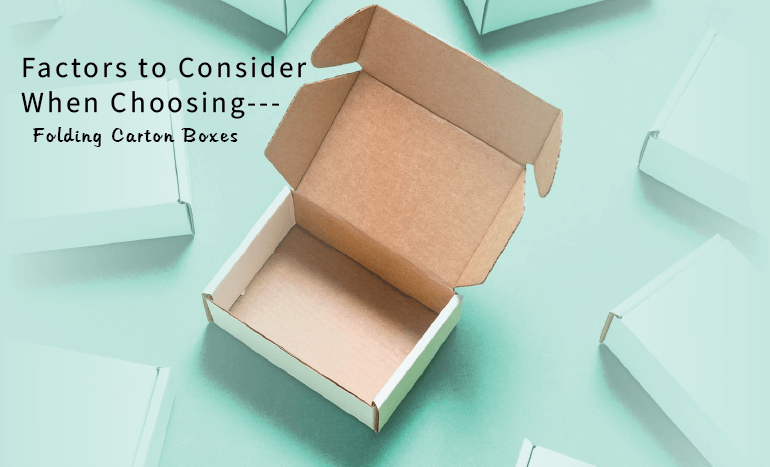Folding carton boxes are crucial in packaging and protecting a wide range of products, including food items, pharmaceuticals, electronics, cosmetics, etc. As a packaging solution, folding cartons offer versatility, convenience, and cost-effectiveness. However, selecting the right folding carton box requires careful consideration of various factors to ensure optimal functionality, branding opportunities, and sustainability. This article will explore the key factors to consider when choosing folding carton boxes.
1. Product Requirements:
Understanding your product requirements is essential for selecting the appropriate folding carton box. Consider the size, weight, fragility, and shape of your product. Ensure the box provides sufficient space, structural integrity, and protection during transportation and storage. Additionally, consider any specific temperature or humidity requirements that your product may have, as this may influence the choice of materials.
2. Box Design and Structure:
The design and structure of the folding carton box are crucial in terms of functionality, branding, and aesthetics. Evaluate the box’s style, such as tuck-end, reverse tuck-end, or straight tuck-end, and determine which best suits your product. Consider additional features like perforations, windows, handles, or inserts, depending on your specific needs. Ensure the box’s design aligns with your brand identity and helps create an appealing and memorable customer experience.
3. Material Selection:
Choosing the right materials for your folding carton boxes is vital for product protection and sustainability. Consider the following options:
- Paperboard: Most folding carton boxes are made from paperboard, which is lightweight, recyclable, and can be printed with high-quality graphics. Select the appropriate thickness and grade of paperboard based on your product’s weight and fragility.
- Coatings and Laminations: Consider coatings or laminations for enhanced protection, barrier properties, and visual appeal. Common options include aqueous coatings, UV coatings, and films like polypropylene or polyester.
- Recyclability and Sustainability: Opt for easily recyclable materials sourced from sustainable or certified suppliers. This choice aligns with environmental values and meets increasing consumer demands for eco-friendly packaging.
4. Printing and Graphics:
The printing and graphics on folding carton boxes are essential for branding and marketing. Consider the printing techniques, such as offset lithography or flexography that can achieve the desired visual impact and color accuracy. Evaluate the box’s surface finish options, including matte, gloss, or spot varnishes, to enhance the overall appearance. Ensure the graphics and branding elements effectively convey your product’s message and align with your brand identity. Utilize our premium Folding Carton Boxes created by Custom Boxes Pack, to up your packaging game.
5. Structural Integrity and Durability:
Assess the folding carton box’s structural integrity and durability to ensure it can withstand the demands of shipping, handling, and storage. The box should be able to protect the product from impacts, vibrations, and stacking pressures. Consider factors such as box strength, edge crush resistance, and stacking capability to avoid potential damages during transportation.
6. Regulatory Compliance:
Ensure the chosen folding carton boxes comply with relevant regulations and standards for your industry and product type. Depending on the product, you may need to meet specific safety, labeling, or food contact requirements. Complying with regulations also demonstrates your commitment to product quality, safety, and consumer well-being.
7. Cost-effectiveness:
Consider the cost implications of the folding carton boxes while ensuring that the chosen packaging solution meets your product’s needs. Evaluate factors such as material costs, production efficiency, and shipping costs. Work closely with packaging suppliers to find the right balance between quality, functionality, and cost.
8. Supplier Capabilities and Reputation:
Select a reputable folding carton box supplier with experience in your industry. Evaluate their production capabilities, quality control processes, and ability to meet your requirements. Consider factors such as turnaround time, order quantities, and their track record in delivering consistent and reliable packaging solutions.
9. Supply Chain Considerations:
Consider the supply chain implications when choosing folding carton boxes. Evaluate factors such as packaging efficiency, storage space, and transportation logistics. Optimize the size and shape of the boxes to maximize the number of units that can fit on pallets or in shipping containers, reducing transportation costs and carbon footprint. Additionally, assess the ease of assembly and packing speed to ensure efficient operations along the supply chain. You can streamline processes, reduce costs, and improve overall efficiency by considering supply chain considerations.
Conclusive Thoughts
Choosing the right folding carton boxes requires careful consideration of various factors, including product requirements, box design, material selection, printing and graphics, structural integrity, regulatory compliance, cost-effectiveness, and supplier capabilities. By thoroughly evaluating these factors, you can also ensure that your packaging solution meets functional requirements and enhances your product’s branding, protection, and sustainability. Selecting the optimal folding carton boxes will contribute to a positive customer experience, increased marketability, and overall business success.

